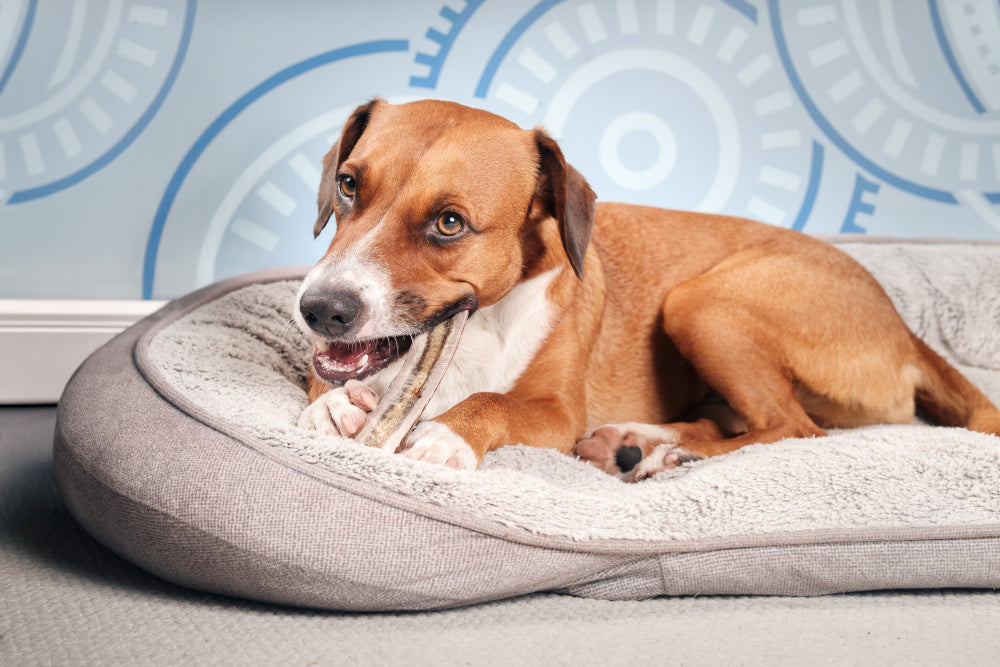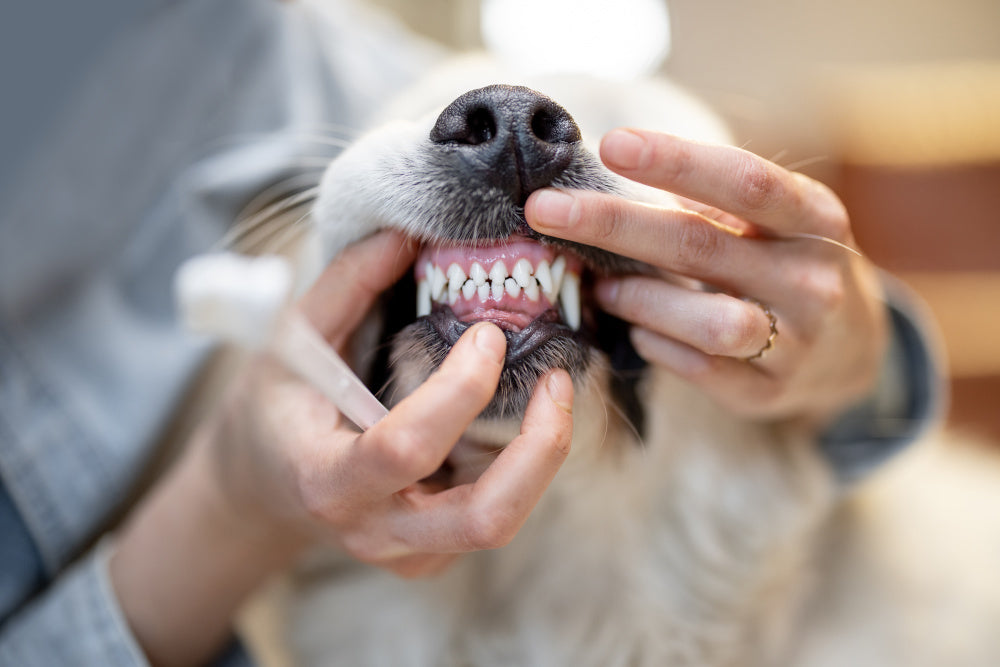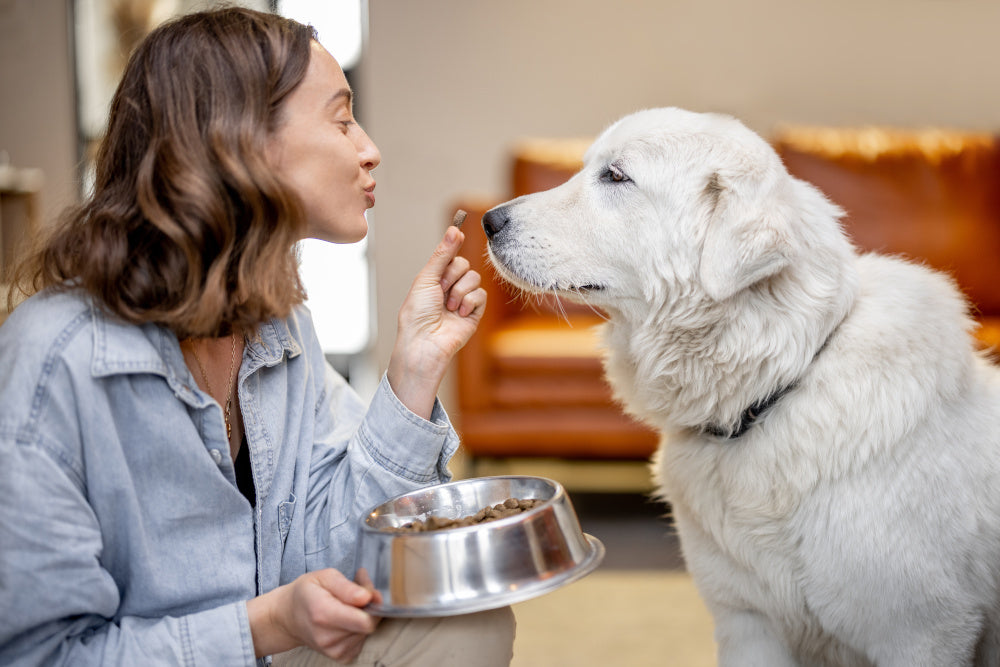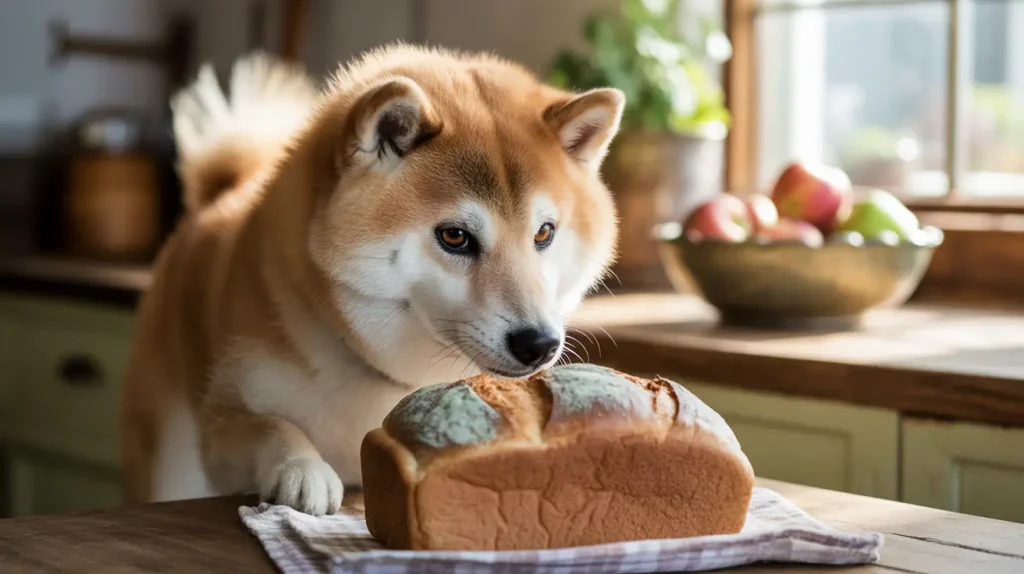Imagine this: you’re cleaning up after dinner, and you notice your dog sniffing around the trash can. Before you can stop them, they’ve gobbled up a piece of moldy food.
You panic, wondering if your furry friend will be okay. If you’ve ever found yourself in this situation, you’re not alone. Many pet owners have been caught off guard by their dog’s quick reflexes and curious nature. But what really happens if a dog eats moldy food?
Is it dangerous, or can your pet shake it off with no problem? We’ll explore the potential risks and what you should do next. Stay with us to learn how to ensure your dog’s safety and well-being.
Common Types Of Moldy Food Dogs Encounter
Dogs are curious creatures, and their interest in food often leads them to samples that are less than fresh. Moldy food is a common hazard they might encounter around the house or yard. Understanding which types of moldy foods are most tempting and risky can help you keep your furry friend safe and healthy.
Fruits And Vegetables
Fruits like strawberries, grapes, and apples can quickly develop mold if left out too long. Vegetables such as tomatoes and cucumbers also spoil and grow mold, especially when stored improperly. You might notice your dog sniffing around a forgotten fruit bowl or a compost bin—have you ever wondered if your dog might actually be attracted to the smell of fermenting produce?
It’s important to remember that some molds on fruits and vegetables produce toxins harmful to dogs. Always check these items before tossing them in your pet’s reach.
Bread And Bakery Items
Stale bread, muffins, and pastries are common sources of moldy food in many homes. These items often get left on counters or tables, making them easy targets for your dog’s scavenging. I once caught my dog happily chewing on a moldy bagel, which made me realize how easily these foods can be within their reach.
Since mold can grow quickly on bakery goods, it’s best to keep these items sealed and out of sight. Moldy bread can cause digestive upset or allergic reactions in dogs, so prevention is key.
Dairy Products
Dairy like cheese, yogurt, and cream can spoil and develop mold if not refrigerated properly. Dogs might be drawn to these creamy treats, increasing their risk of eating something harmful. Have you noticed your dog lingering around the fridge door or trash after you’ve discarded old dairy products?
Moldy dairy can lead to stomach issues or even more serious health problems. Always check expiration dates and store these foods correctly to protect your pet.
Leftover Human Meals
Leftovers often contain a mix of ingredients that can spoil and grow mold quickly. Dogs are notorious for helping themselves to scraps left unattended on plates or counters. One time, my dog managed to get into a container of moldy pasta, which made me realize how easily leftovers can become a hazard.
Be mindful of where you place your leftovers and dispose of any spoiled food promptly. Moldy leftovers can lead to poisoning or digestive troubles for your dog, so vigilance is essential.

Credit: www.nextritionpet.com
Health Risks From Moldy Food
Moldy food poses serious health risks to dogs. Eating spoiled items can lead to various health problems. The severity depends on the type of mold and the amount ingested. Some molds produce harmful toxins that affect different organs. Understanding these risks helps pet owners act quickly and protect their dogs.
Gastrointestinal Issues
Moldy food often causes stomach upset in dogs. Vomiting and diarrhea are common signs. Dogs may also show loss of appetite and abdominal pain. These symptoms can appear within hours of eating moldy food. Dehydration can develop if vomiting and diarrhea persist.
Toxic Reactions
Some molds produce mycotoxins harmful to dogs. These toxins can affect the liver, kidneys, and nervous system. Symptoms include weakness, tremors, and seizures. Toxic reactions may require immediate veterinary care. The outcome depends on toxin type and exposure level.
Allergic Responses
Dogs can develop allergies to mold spores in spoiled food. Signs include itching, redness, and swelling of the skin. Sneezing and watery eyes may also occur. Allergic reactions vary in severity from mild to severe. Avoiding mold exposure helps reduce these risks.
Long-term Effects
Repeated mold exposure can cause lasting health problems. Chronic liver or kidney damage may develop over time. Immune system suppression is another possible effect. Dogs with ongoing mold ingestion need thorough veterinary check-ups. Early detection helps prevent serious conditions.
Signs Your Dog Ate Moldy Food
Noticing the signs your dog ate moldy food is crucial for their health. Mold can cause serious problems. Dogs cannot always show illness clearly. Watch closely for changes in behavior or health. Acting fast can prevent severe illness.
Vomiting And Diarrhea
Vomiting and diarrhea are common signs of mold poisoning. Your dog may throw up soon after eating. Loose or watery stools often follow. These symptoms show the body is trying to get rid of toxins. They can last for a few hours or days.
Lethargy And Weakness
Mold toxins can make dogs very tired. Your dog may seem weak and less active. They might not want to play or go for walks. This lack of energy is a clear warning sign. It means the body is struggling to cope.
Excessive Drooling
Drooling more than usual can signal mold ingestion. This happens because mold irritates the mouth and throat. Excess saliva protects the mouth from toxins. Watch for wet fur around the mouth and chin. It often appears soon after eating moldy food.
Loss Of Appetite
A sudden refusal to eat is a red flag. Mold toxins can upset a dog’s stomach. This causes nausea and a loss of hunger. Your dog may ignore favorite treats or meals. Loss of appetite can lead to weakness if it lasts long.

Credit: www.nextritionpet.com
Immediate Actions To Take
Discovering that your dog has eaten moldy food can be alarming. Taking the right steps immediately can help prevent serious health issues and give you peace of mind. Here’s what you need to do right away to protect your furry friend.
Remove Access To Moldy Food
First, quickly take away any remaining moldy food to stop your dog from eating more. Check nearby areas, including trash bins and hidden spots where they might have found the food. Preventing further ingestion is crucial to avoid worsening symptoms.
Monitor Your Dog Closely
Keep a close eye on your dog for any signs of illness, such as vomiting, diarrhea, lethargy, or unusual behavior. You might notice drooling, loss of appetite, or even trembling. Tracking these symptoms helps you understand how serious the situation is and prepares you to provide accurate information to your vet.
Contacting Your Veterinarian
Call your vet as soon as possible to describe what happened and the symptoms you observe. Your vet can give you advice on whether your dog needs to come in for an examination or if home care is sufficient. Don’t hesitate to ask questions about possible treatments or signs to watch for at home.
When To Visit The Emergency Clinic
Some symptoms require urgent care. If your dog is having trouble breathing, persistent vomiting, seizures, or extreme lethargy, head straight to the emergency clinic. Timely intervention can make a significant difference in recovery, so trust your instincts if you feel the situation is serious.
Veterinary Treatments And Procedures
When your dog eats moldy food, prompt veterinary care is crucial. The treatment depends on the type of mold, the amount ingested, and your pet’s symptoms. Understanding the common veterinary treatments can help you stay calm and act quickly if this happens to your furry friend.
Decontamination Methods
Veterinarians often start by removing the toxic substance from your dog’s system. This can involve inducing vomiting to clear the stomach if the ingestion was recent. Activated charcoal may be given to bind toxins and prevent absorption into the bloodstream.
In some cases, your vet might perform a gastric lavage, which is a gentle stomach wash. These methods require professional handling, so avoid trying to induce vomiting at home without veterinary advice.
Medication Options
After decontamination, your dog may receive medications to manage symptoms and prevent complications. Anti-nausea drugs help ease vomiting, while fluids combat dehydration caused by diarrhea or vomiting. In cases of fungal toxin exposure, specific antifungal or supportive therapies might be necessary.
Antibiotics may be prescribed if there’s a risk of secondary infections. Your vet will tailor the medication based on your dog’s condition, so follow their instructions carefully.
Hospitalization Criteria
Some dogs require hospitalization for close monitoring and intensive treatment. If your dog shows severe symptoms like seizures, difficulty breathing, or persistent vomiting, overnight care is often recommended. Hospitalization allows vets to provide intravenous fluids, oxygen, and continuous observation.
Consider hospitalization if your dog is very young, old, or has underlying health issues, as they are more vulnerable to complications. Would you want your dog left alone during a critical time?
Follow-up Care
Recovery doesn’t end at the vet’s office. Follow-up appointments are essential to ensure your dog’s health is improving and no delayed effects appear. Your vet may recommend blood tests or additional treatments depending on the initial severity.
Keep a close eye on your dog’s appetite, behavior, and bowel movements after treatment. Early detection of any relapse can prevent serious health problems. Have you noticed subtle changes in your dog’s behavior after an illness before?
Preventing Moldy Food Ingestion
Preventing your dog from eating moldy food is crucial for their health and safety. Mold can grow quickly on leftovers, pet food, and even treats, posing serious risks. Taking simple steps around your home can help you keep moldy food away from your furry friend.
Proper Food Storage
Store all dog food and treats in airtight containers to keep moisture and air out. This slows down mold growth and keeps the food fresh longer. Refrigerate leftovers promptly and avoid leaving food out for extended periods.
Think about how often you check the expiration dates on your pet’s food. Regularly rotating stock and discarding old items can prevent mold buildup without much effort.
Regular Trash Management
Dogs are natural scavengers and may dig through trash if it smells tempting. Use trash cans with secure lids to block access. Empty garbage frequently, especially food scraps, to reduce the chance of moldy food lingering around.
Have you noticed your dog getting into the trash when you’re not looking? This simple step can stop many mold-related emergencies before they start.
Training And Supervision
Teach your dog the “leave it” command to discourage them from eating anything off the floor. Consistent training helps your dog understand boundaries and avoid harmful foods. Supervise your dog during meal times and walks to catch any risky behavior early.
Dogs are curious, but you can guide their curiosity safely. How often do you find yourself distracted when your pet sneaks a bite of something they shouldn’t?
Safe Treat Alternatives
Offer fresh, mold-free treats like carrot sticks or apple slices instead of store-bought snacks that might spoil quickly. Homemade treats allow you to control ingredients and freshness. Always check for signs of mold before giving any treat to your dog.
Providing safe options reduces the temptation to scavenge for spoiled food. What healthy treats does your dog enjoy the most?

Credit: www.nextritionpet.com
Frequently Asked Questions
What Are The Symptoms If A Dog Eats Moldy Food?
Dogs may show vomiting, diarrhea, drooling, lethargy, and loss of appetite. Severe cases might include tremors or seizures. Immediate vet care is crucial for proper diagnosis and treatment.
Can Moldy Food Cause Poisoning In Dogs?
Yes, moldy food can contain harmful toxins that cause poisoning. These toxins affect the dog’s digestive and nervous systems. Prompt veterinary attention helps prevent serious health complications or death.
How Quickly Do Symptoms Appear After Eating Moldy Food?
Symptoms usually appear within a few hours after ingestion. Early signs include vomiting and diarrhea. Quick action can improve the dog’s recovery and reduce risks.
Should I Induce Vomiting If My Dog Ate Moldy Food?
Do not induce vomiting without veterinary guidance. Some mold toxins can worsen with vomiting. Contact your vet immediately for safe and proper advice.
Conclusion
Dogs eating moldy food can face health risks like vomiting and diarrhea. Watch your pet closely for any unusual signs. Prompt action helps prevent serious problems. Always keep food fresh and out of reach. Knowing the risks keeps your dog safe and healthy.
Stay alert, and contact your vet if needed. Your dog’s well-being depends on your care and attention.

